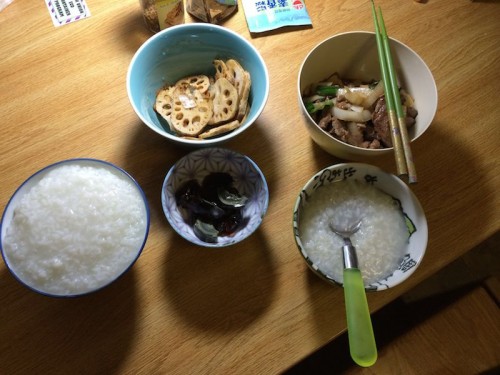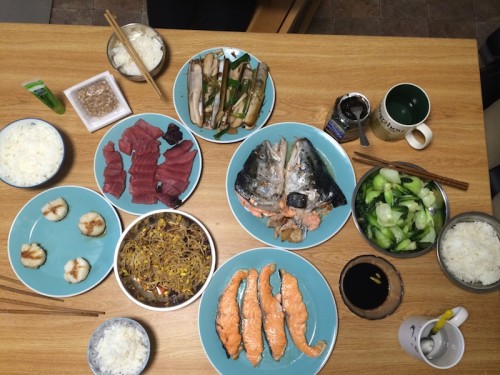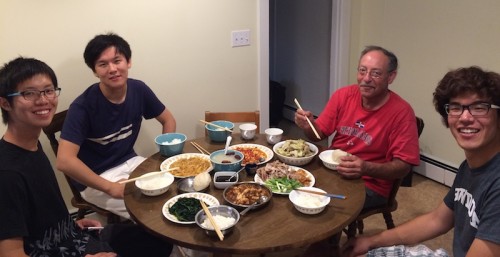Culinary Education: International Students Ease Homesickness With Cooking
By Bowdoin
“There isn’t much to eat,” said Lu “Max” Miao ’17, a junior at Bowdoin College. He wandered around the dining hall, peering at the countertops covered with food. A long line of students waited behind him to fill their plates at one of the top college dining halls in the U.S.
The choices that night were dazzling: pickled Bowdoin Organic Garden beet salad, flounder with dijon white wine sauce, organic tofu steak with onions and portobello mushrooms, garlic nan bread, assorted popsicles — to name a few of the offerings. But in the end, Miao gave up. “I’m going to use the public kitchen to boil some noodles. Oh, also some fermented dry vegetables that Grandma gave me when I left Hangzhou,” he said.
Miao, who grew up in China and came to study in the United States when he was 14, is not the only international student to pick on dining hall food. Jing Trerayapiwat ’16, a Bowdoin senior from Thailand, observed, “The salad bar is pretty good, but I’m not impressed by the Asian dishes, especially the pad thai.” Trerayapiwat added that his favorite Thai “restaurant” in America was the “MIT kitchen.” He periodically travels south to visit his friends at Massachusetts Technology Institute where they make Thai dishes together.
Last April, the Chinese publication This is America published an article, “Why Have Chinese Students in the U.S. Become Good Cooks?”, which spread rapidly on Chinese websites and social media. It is not uncommon to see online posts from Chinese students living in the United States that show photos of their meal masterpieces. Ask overseas Chinese students what they like to do at Chinese gatherings and you are likely to get a consensus: cook and eat together.
One reason why Chinese students become good cooks, according to the author of the article, is that most American Chinese food is disappointing. Mike Feldman, a host parent in Bowdoin’s host family program and an amateur Chinese cook, described the universal experience of ordering the staple American Chinese dish, General Tso’s chicken. “It’s just got a tiny piece of chicken inside a deep fried dough and at the end of the meal you feel sick because you’ve just been eating oily, heavy dough,” he said.
The second reason offered — that good Western food is expensive — does not explain why many international students choose to make their own food when tasty, healthy and affordable Western food is accessible at colleges like Bowdoin. What students seek in a dish is less about its tastiness and more about how much it reminds them of meals they eat at home.

When Miao started his second semester at Bowdoin, he quickly recognized a need to make home dishes for himself and his Chinese friends. “Unlike other students in New York City or California, we don’t get real Chinese food in this small New England town, and not everyone has a kitchen or the time to cook,” he said. His solution was to propose a congee display table at Moulton Union dining hall. The dining hall approved his idea, and since then Miao has been making congee every Sunday brunch. Congee, plain rice porridge, is a dish found across China and comforts the stomachs of millions of Chinese. It is what chicken noodle soup is to Americans. Other Asian countries also make a similar dish. Indonesians call it burbur and Koreans call it jook.
In China, mothers make an array of side dishes to accompany the simple congee. Miao said some non-Asian students occasionally try his congee, but most stick with big scoops of the less exotic side dishes. “I try very hard to imitate the taste of home, but the ingredients are different here. Cabbages aren’t as sweet, meat isn’t as flavorful, and you quickly run out of leafy greens to choose from,” he said. Once in a while, Miao does discover the taste of home at Brunswick’s farmer’s markets, but the benefit is not always worth the cost. A small bunch of bok choy, for example, costs $4 in Maine, whereas in China one can buy twice the volume for about $1. Miao’s congee has become a much anticipated dish that drives Asian international students out of their beds on Sunday morning. “Is the congee gone?!” Miao often receives frantic messages from his Asian friends while working.
Zhao said that she was often “moved” and “healed” by Miao’s congee during her time at Bowdoin. A bland and modest dish, congee is not something children normally appreciate, but Zhao said she had craved it since coming to the United States. “When you are depressed from the infinite snowstorms and anxious about your life in the U.S., it’s simply comforting to eat something you remember from home,” she said. Chinese international students often suffer from anxiety, a result of being disconnected from their social support systems and struggling to compete for employment opportunities due to the constraints of visa eligibility.
As of 2014, there were 274,000 Chinese international students in the United States. Many are only children who never needed to cook when they were at home in China. When they go abroad, however, they often surprise their families with their newfound interest in cooking.(“Since when have you switched to a culinary major?” was my father’s response when he noticed how much his daughter was cooking in the States.) The overseas students practice and practice, recognizing that cooking is the easiest remedy to ease their homesickness, even faster than Skype. Ran Xie, a graduate from McMaster University in Ontario, said, “I know my mom’s method is wrong, but I still fight with my boyfriend over whether we should add the garlic first or last.”

Lu Miao ’17, Hanzhao Li ’18, Mike Feldman, and Jack Jia ’19 (left to right)



